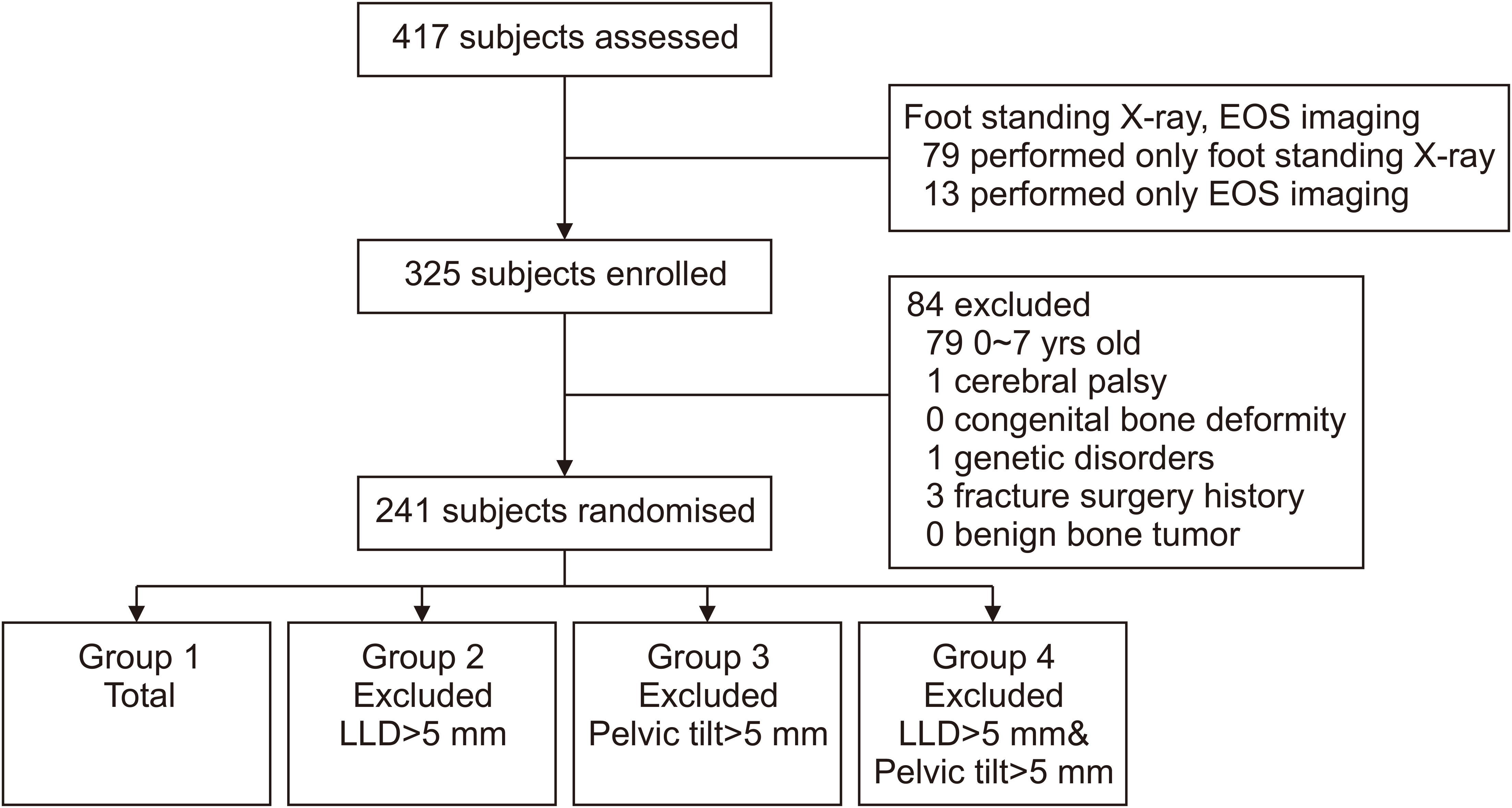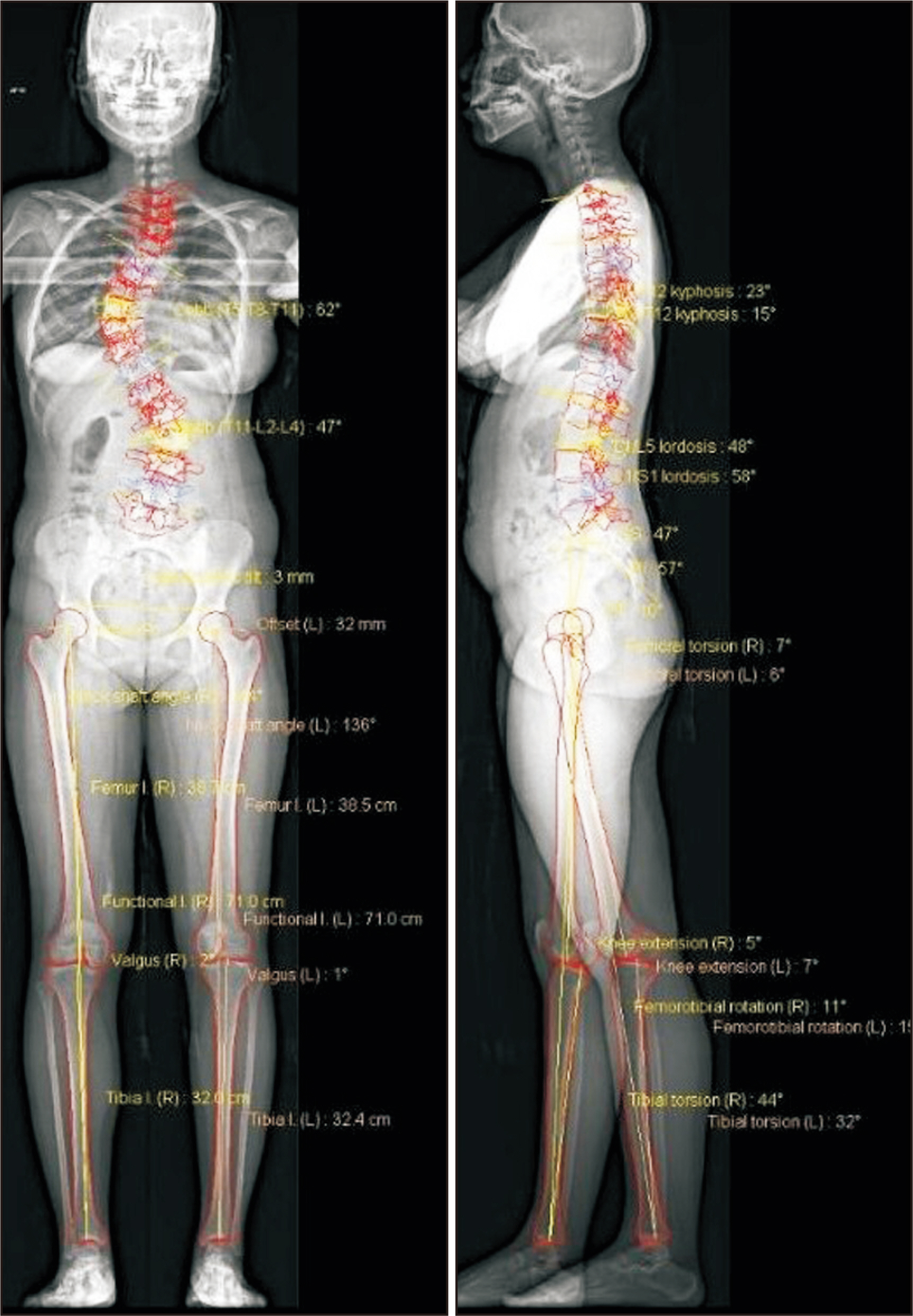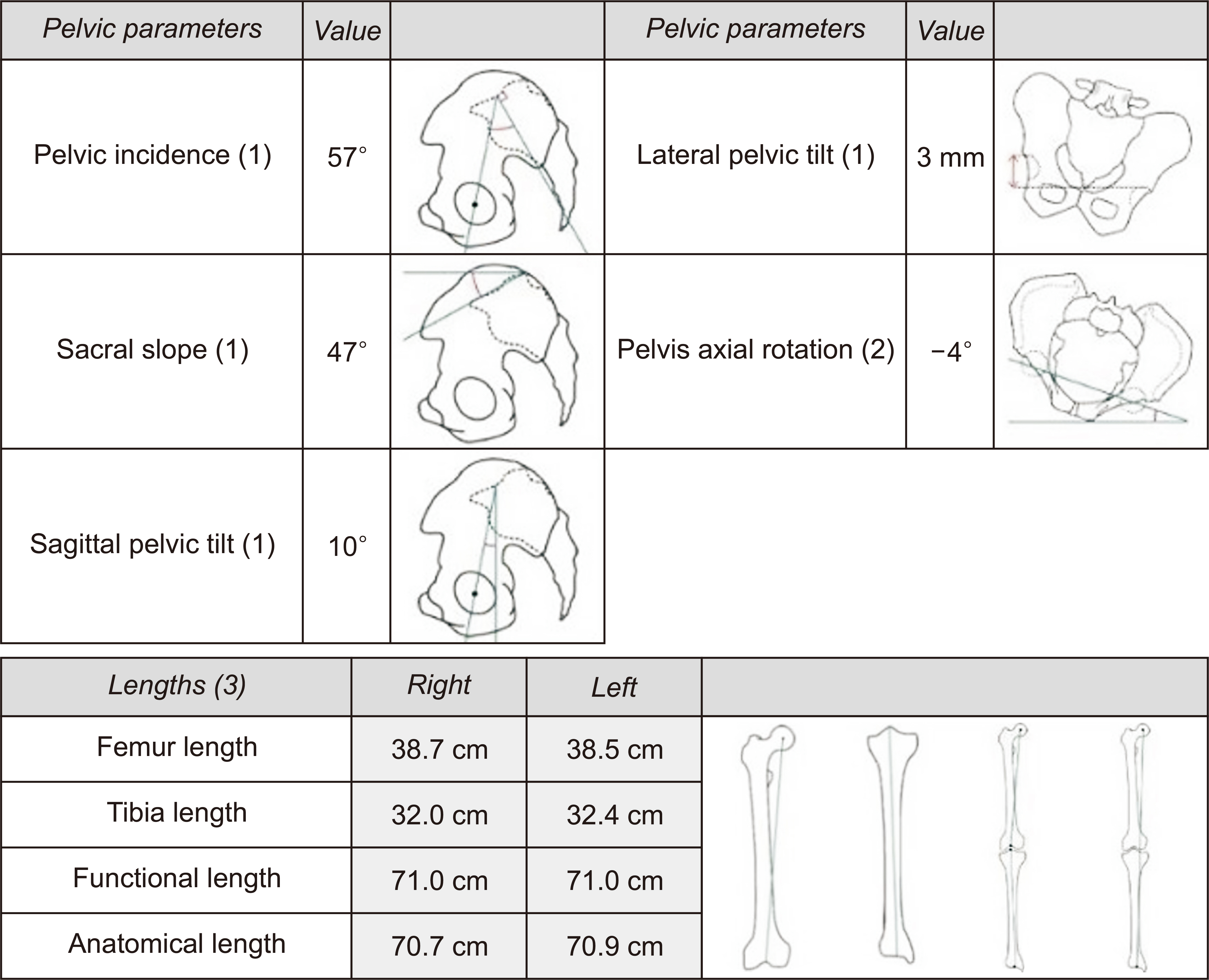J Korean Foot Ankle Soc.
2024 Jun;28(2):48-54. 10.14193/jkfas.2024.28.2.48.
Relationship between Bony Alignment of Foot and Scoliosis in Children and Adolescent
- Affiliations
-
- 1Department of Orthopedic Surgery, Konyang University Hospital, Konyang University College of Medicine, Daejeon, Korea
- KMID: 2556553
- DOI: http://doi.org/10.14193/jkfas.2024.28.2.48
Abstract
- Purpose
Foot alignment affects the overall balance and alignment of the body. This study examined the relationship between the foot parameters and scoliosis in children and adolescents through simple radiographs.
Materials and Methods
Two hundred and forty-one outpatients under 15 years old from 2013 to 2022 were evaluated. Patients with an abnormal leg length discrepancy or pelvic tilt were screened. The patients included were divided into four groups. Each group was tested to determine if they had scoliosis. The foot anterior-posterior/lateral X-rays were selected for the foot parameters, and the EOS system was used for the spline and pelvis parameters.
Results
A t-test of all groups showed no statistically significant difference as the p-value exceeded 0.05. An analysis of variance (ANOVA) comparing the Cobb’s angle and foot parameters did not show a significant correlation. On the other hand, female and older patients had a higher Cobb’s angle.
Conclusion
No direct relationship was noted between scoliosis and the foot parameters that could be measured radiographically among children and adolescents. In addition, no correction between the Cobb’s angle and foot parameters was found.
Figure
Reference
-
1. Menz HB, Morris ME, Lord SR. 2005; Foot and ankle characteristics associated with impaired balance and functional ability in older people. J Gerontol A Biol Sci Med Sci. 60:1546–52. doi: 10.1093/gerona/60.12.1546. DOI: 10.1093/gerona/60.12.1546. PMID: 16424286.
Article2. Zafiropoulos G, Prasad KS, Kouboura T, Danis G. 2009; Flat foot and femoral anteversion in children--a prospective study. Foot (Edinb). 19:50–4. doi: 10.1016/j.foot.2008.09.003. DOI: 10.1016/j.foot.2008.09.003. PMID: 20307449.
Article3. Muzafarovna KS. 2022; With scoliosis in children, changes in the morphological parameters of the foot. Res J Trauma Disabil Stud. 1:17–23.4. Muzafarovna KS. 2023; Pathological changes of the foot in children with scoliosis. J Humanit Artif Intell. 2:148–53.5. Puzovic V, Rotim K, Jurisic V, Samardzic M, Zivkovic B, Savic A, et al. 2015; The prevalence of spine deformities and flat feet among 10-12 year old children who train basketball--cross-sectional study. Coll Antropol. 39:625–9.6. Muzaffarovna KS, Aleksandrovna XE, Jumayevich TS. 2021; Morphofunctional features of the feet in children with scoliosis, depending on their constitutional, gender and age characteristics. Turk Online J Qual Inq. 12:9505–13.7. Krul M, van der Wouden JC, Schellevis FG, van Suijlekom-Smit LW, Koes BW. 2009; Foot problems in children presented to the family physician: a comparison between 1987 and 2001. Fam Pract. 26:174–9. doi: 10.1093/fampra/cmp018. DOI: 10.1093/fampra/cmp018. PMID: 19270034.
Article8. Parr A, Askin G. 2020; Paediatric scoliosis: update on assessment and treatment. Aust J Gen Pract. 49:832–7. doi: 10.31128/AJGP-06-20-5477. DOI: 10.31128/AJGP-06-20-5477. PMID: 33254215.
Article9. Rehm J, Germann T, Akbar M, Pepke W, Kauczor HU, Weber MA, et al. 2017; 3D-modeling of the spine using EOS imaging system: inter-reader reproducibility and reliability. PLoS One. 12:e0171258. doi: 10.1371/journal.pone.0171258. DOI: 10.1371/journal.pone.0171258. PMID: 28152019. PMCID: PMC5289552.
Article10. Abrisham SMJ, Ardekani MRS, Mzarch MAB. 2020; Evaluation of the normal range of thoracic kyphosis and lumbar lordosis angles using EOS imaging. Maedica (Bucur). 15:87–91. doi: 10.26574/maedica.2020.15.1.87.11. Mjaess G, Karam A, Labaki C, Karam M, Bakouny Z, Ghanimeh J, et al. 2020; What is the most reliable radiographic method to evaluate the longitudinal foot arch? Application in subjects with adolescent idiopathic scoliosis. Orthop Traumatol Surg Res. 106:1263–8. doi: 10.1016/j.otsr.2019.11.024. DOI: 10.1016/j.otsr.2019.11.024. PMID: 32035816.
Article12. Park MS, Kwon SS, Lee SY, Lee KM, Kim TG, Chung CY. 2013; Spontaneous improvement of radiographic indices for idiopathic planovalgus with age. J Bone Joint Surg Am. 95:e193(1-8). doi: 10.2106/JBJS.M.00301. DOI: 10.2106/JBJS.M.00301. PMID: 24352779.
Article13. Al-Aubaidi Z, Lebel D, Oudjhane K, Zeller R. 2013; Three-dimensional imaging of the spine using the EOS system: is it reliable? A comparative study using computed tomography imaging. J Pediatr Orthop B. 22:409–12. doi: 10.1097/BPB.0b013e328361ae5b. DOI: 10.1097/BPB.0b013e328361ae5b. PMID: 23652967.14. Kanto M, Maruo K, Tachibana T, Fukunishi S, Nishio S, Takeda Y, et al. 2019; Influence of spinopelvic alignment on pelvic tilt after total hip arthroplasty. Orthop Surg. 11:438–42. doi: 10.1111/os.12469. DOI: 10.1111/os.12469. PMID: 31148364. PMCID: PMC6595105.
Article15. Laeeque M, Nirmale VK, Diwan CV. 2013; Study of prevalence of tibial length inequality on both sides. Int J Recent Trends Sci Technol. 5:161–3.16. Kim SB, Heo YM, Hwang CM, Kim TG, Hong JY, Won YG, et al. 2018; Reliability of the EOS imaging system for assessment of the spinal and pelvic alignment in the sagittal plane. Clin Orthop Surg. 10:500–7. doi: 10.4055/cios.2018.10.4.500. DOI: 10.4055/cios.2018.10.4.500. PMID: 30505420. PMCID: PMC6250964.
Article17. Kim JH. 2013; Prevention and treatment of hallux valgus. J Korean Med Assoc. 56:1017–22. doi: 10.5124/jkma.2013.56.11.1017. DOI: 10.5124/jkma.2013.56.11.1017.
Article18. Kumar SJ, MacEwen GD. 1982; Torsional abnormalities in children's lower extremities. Orthop Clin North Am. 13:629–39. DOI: 10.1016/S0030-5898(20)30259-5.
Article19. Ganeb SS, Egaila SES, Younis AA, El-Aziz AMA, Hashaad NI. 2021; Prevalence of lower limb deformities among primary school students. Egypt Rheumatol Rehabil. 48:34. doi: 10.1186/s43166-021-00082-1. DOI: 10.1186/s43166-021-00082-1.
Article20. Park J, Lee SG, Bae J, Lee JC. 2015; The correlation between calcaneal valgus angle and asymmetrical thoracic-lumbar rotation angles in patients with adolescent scoliosis. J Phys Ther Sci. 27:3895–9. doi: 10.1589/jpts.27.3895. DOI: 10.1589/jpts.27.3895. PMID: 26834376. PMCID: PMC4713815.
Article21. Kim S, Uhm JY, Chae DH, Park Y. 2020; Low body mass index for early screening of adolescent idiopathic scoliosis: a comparison based on standardized body mass index classifications. Asian Nurs Res (Korean Soc Nurs Sci). 14:24–9. doi: 10.1016/j.anr.2019.12.003. DOI: 10.1016/j.anr.2019.12.003. PMID: 31923468.
Article
- Full Text Links
- Actions
-
Cited
- CITED
-
- Close
- Share
- Similar articles
-
- Medical genomic approach to early-onset scoliosis
- Normal Age-Adjusted Sagittal Spinal Alignment Is Achieved with Surgical Correction in Adolescent Idiopathic Scoliosis
- Etiology of Adolescent Idiopathic Scoliosis: A Literature Review
- Spontaneous Rib Fracture during Boston Brace Treatment for Adolescent Idiopathic Scoliosis
- Response to: Evidence-Based of Nonoperative Treatment in Adolescent Idiopathic Scoliosis





